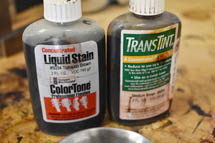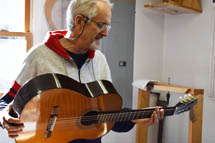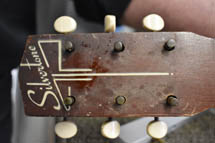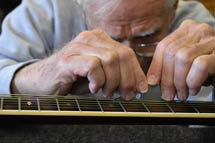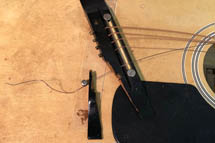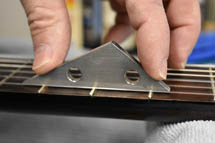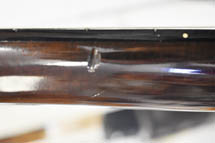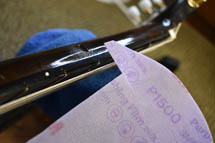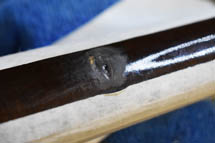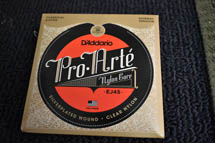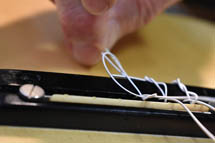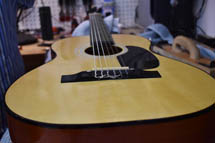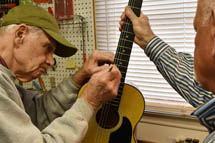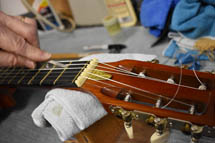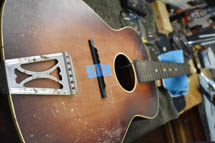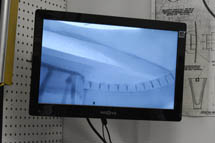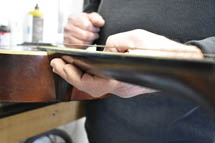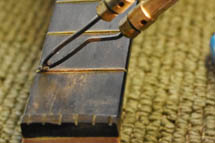Repair Workshop
Feb 15, 2020
Attendees:
- Chet Dickerson
- Howard Wilson
- Jack Gellerstedt
- Steve Clark
- Kenny Craft
- David Motley
- Dennis McKim
- Tom Pafford
- Gary Mellas
Click on any image to start the slide show.
Fret Holder
When removing frets, it's good to have a way to remember where they came from if you plan to reuse them.
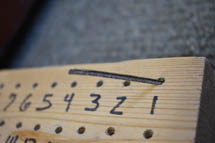
Inspection camera
Chet says: It’s pretty old. Manufactured by KT&C. I bought it online. The SS base is something I had lying around so I attached the U-bracket to it.

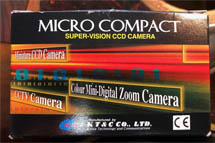
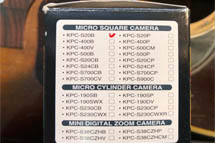
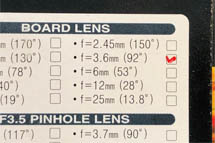

Chet's shop in Roanoke, VA
(Notes: Dennis McKim and Howard Wilson. Photos: Howard Wilson)
We worked on three guitars - the Truetone nylon string, Harmony nylon string, and the Silvertone steel string. See the Jan. 18 notes for description of starting condition of all guitars.

The Truetone Classical Guitar
We checked the TT with the fret rocker tool and found the 3rd fret was high. It was dressed and crowned with files. We used Chet's glass plane to check the other frets. High spots were sanded level with 320 grit attached to a glass plane, then re-crowned. They were then polished with 1000 grit and 0000 steel wool
The guitar had several dents and dings on the neck deep enough to be noticeable when playing.
The photo below shows the set up for the neck divot repair. Notice the low tack tape draped over the neck. Similar piece on the back side below the divot. The clamp held the guitar in position which left the divot mostly level.
A few drops of CA glue were added to divot and left for 15-30 seconds before spraying lightly with accelerant (also called activator) to speed up drying time. Additional drops of CA glue followed by accelerant were applied until the dent was built up. We leveled it using the razor blade trick (covering the outer edges of the blade with tape and using only the exposed part to scrape). Despite being cautious we managed to scrape through to bare wood. We found out how quickly a small touch up can morph into something much bigger if you aren’t extremely careful!
Steve mixed a couple tints together with shellac and the filled areas were then touched up using tinted shellac. The tinted shellac was also brushed on to some scratches on the back.
Some finish work remains but the Truetone guitar was playable at the end of the day. Gary played a nice piece on it for us.

Harmony 3/4 size guitar
The Harmony guitar was strung up and tuned.
The action was low and we adjusted the saddle up. This guitar had a saddle fit into a metal channel with adjusting screws on each end all fit into the bridge.
It also has a zero fret at the nut end. We discovered loud buzzing on both D and G strings. After more adjustment it still buzzed. We found high frets again with the rocker tool and hammered them in but still buzzed. Checking the neck relief revealed very little relief.
There were a couple of strings that were buzzing while played open. Chet found that the string contact to the zero fret was minimal (little pressure), so he lowered the nut slots and angled the slots back toward the headstock to provide more downward force on the zero fret. This helped with the open buzzing but also found the first fret to be high and was causing some buzz played open. We hammered down frets that were raised and leveled several others.
Inspecting the saddle we discovered it was installed backwards in the metal channel piece. We installed a shim (.060 thick) under the saddle. This improved the buzzing except at the 6th fret on the low E string. This fret was found to be loose and was glued with CA glue. The guitar was playable with buzzing and action problems brought to acceptable conditions.
Silvertone
Initial assessment - Silvertone, model 605, circa 1950s-1960s, number stamped on inside back plate 4995H605, 12- fret, ladder braced top, floating bridge with tailpiece, some warpage on back plate, Ebony fretboard, Ebony nut, brass frets, solid headstock with no tuner bushings, needs neck reset
We decided to string up the Silvertone with some old strings and evaluate from there. We inspected the inside with Chet's mini camera connected to the monitor so everyone could see. The bracing was intact and the back is solid but has a noticeable bubble.
The neck had .038 neck relief which is too much. We loosened the strings and checked again and got .023, still too high. The guitar has an incorrect neck angle.
Some alternatives were discussed including a neck reset and whether to reuse the floating bridge. We decided to try to remove some frets and dress the fingerboard down.
Frets proved difficult to remove even with soldering iron heat, with large pieces of fingerboard (ebony) coming up with the frets. Need to introduce moisture into fingerboard until next meeting.
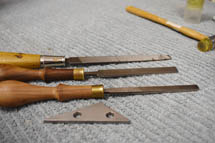
 sm.jpg)

